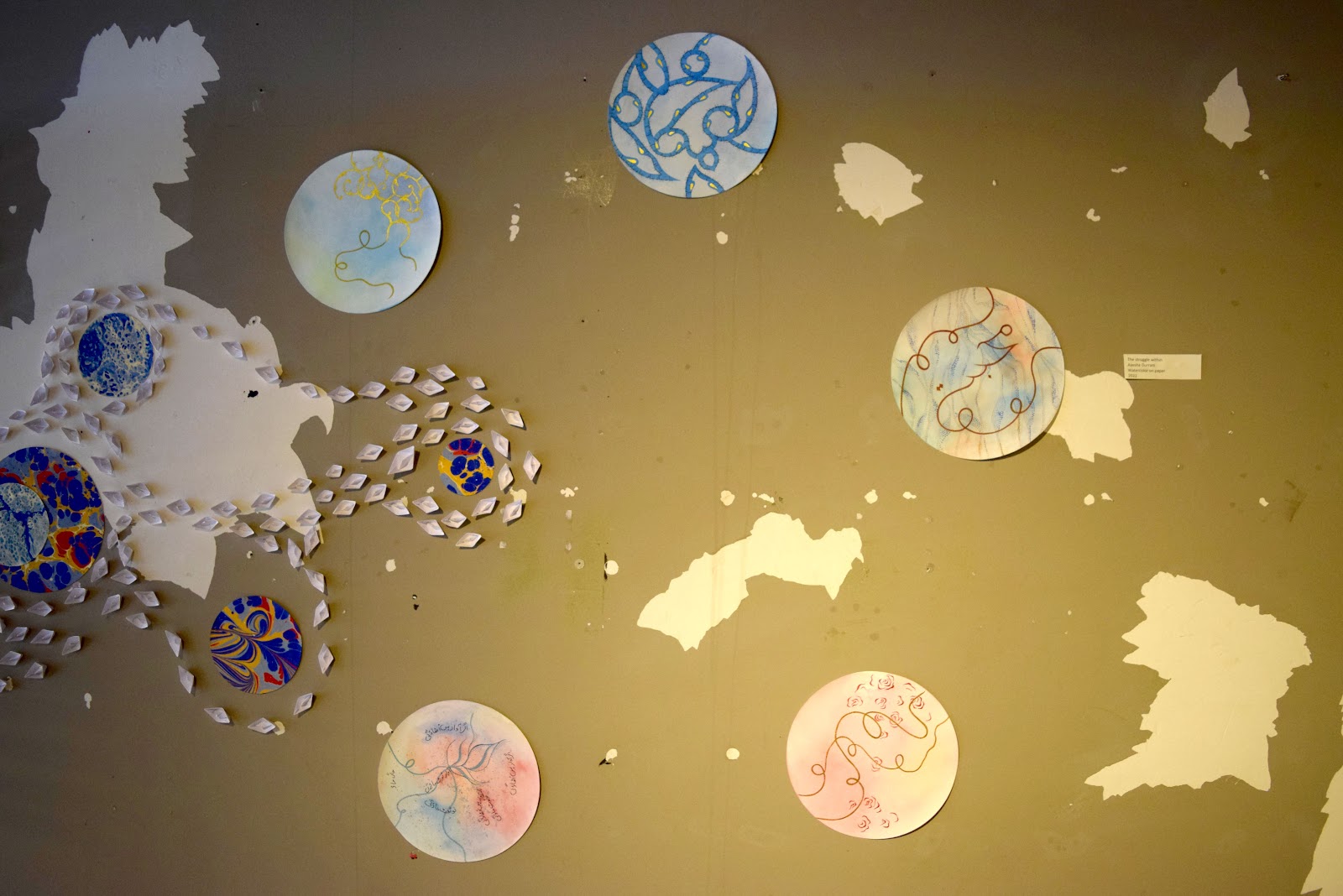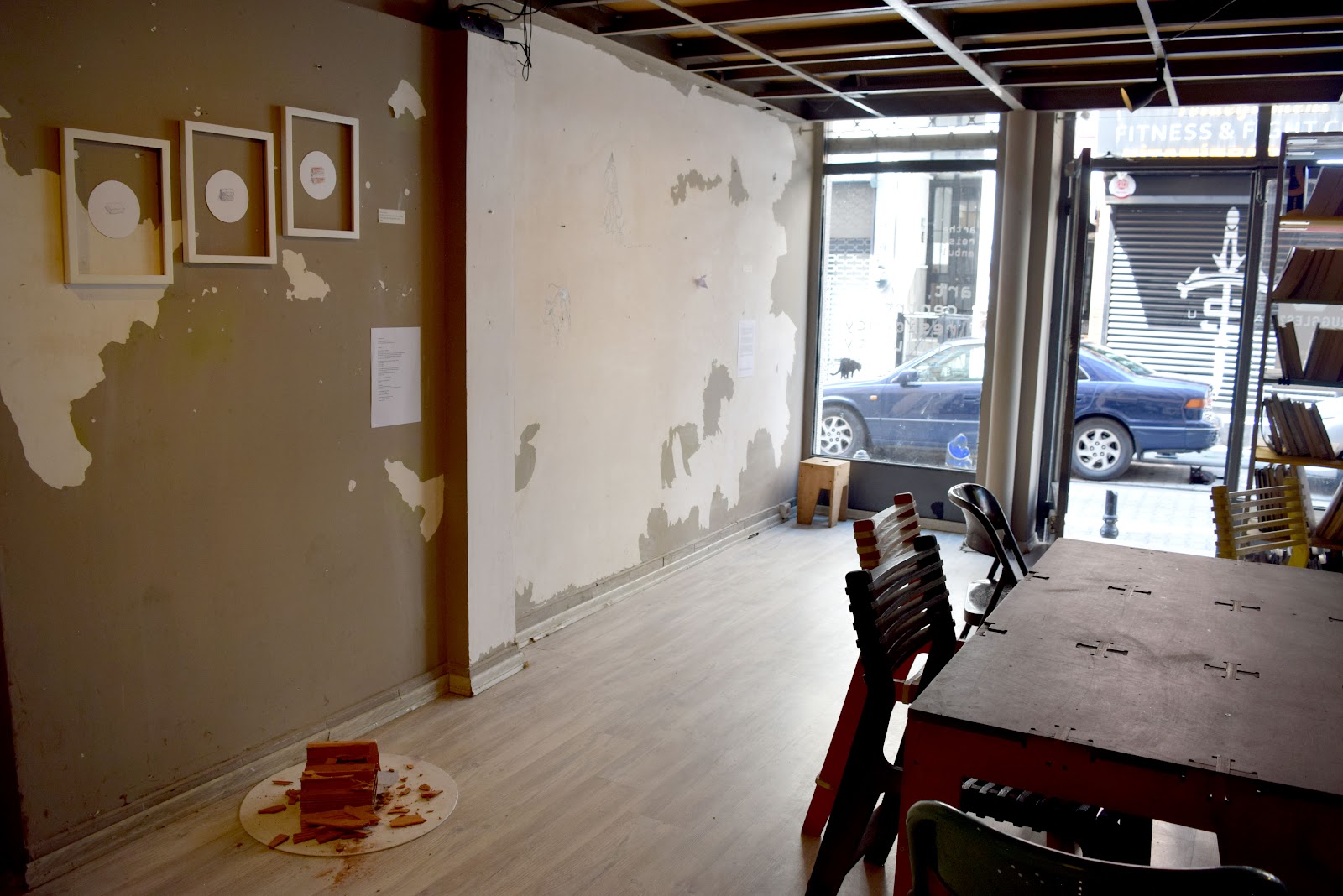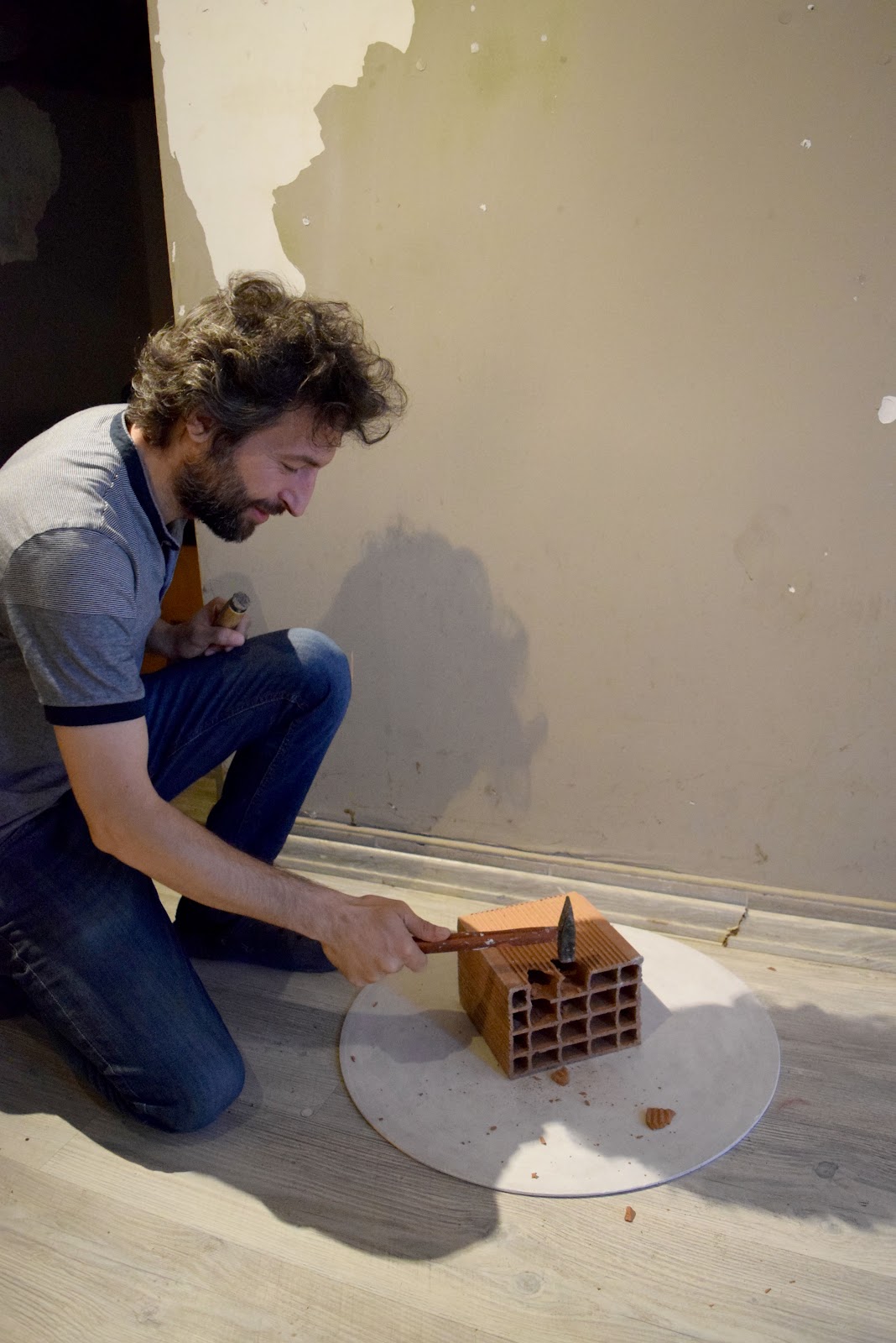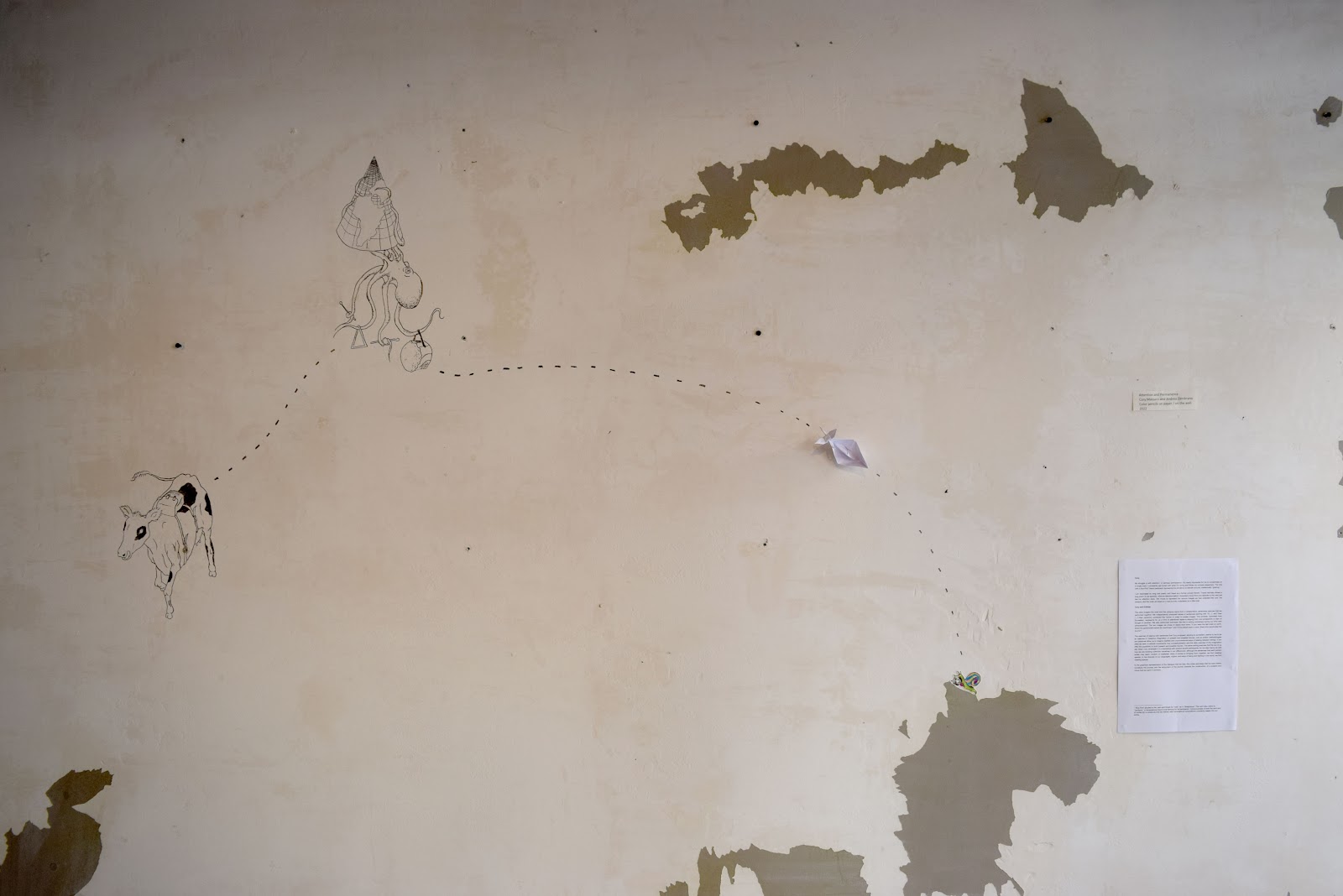What Is Your Struggle? What Are Our Struggles?
Project by Andrea Zambrano Rojas
Collaborative exercises with Ayesha Durrani, Ali Omar and Cory Massaro
Andrea:
"What are our struggles?" The question that has been haunting me for some years, both individually and in collectives, in the effort to support, and embrace those of us who struggle. During these days of sharing with other artists as a part of art residency in Arthere Istanbul, we have walked together with that question as a starting place. With Ayesha, from Pakistan, we have influenced each other to create new works and install them together: Her struggle has been with 'love' and her identity, and I am talking about movement in a collective, accompanied way. With Ali Omar, from Syria, we have worked on a joint project considering his experience of the destruction. With Cory, from the United States, we have set out to think about attention and permanence. The collaborative exercises that we present here, show a little bit of that which hurts us, and that which moves us, and that which calls us to come together to share, create, fight...
The dialogues with Shirin, Dhoha and Suha are still in sketches and it will take us a little time to materialize them as pieces of art, if that is our wish, but I thank you infinitely for the time we've shared.
Ayesha:
"Being a woman is a bittersweet experience.
Life is a struggle, but just being a woman is a struggle in itself. It feels like you are being watched at all times, and everyone is waiting for you to falter. There are hurdles every step of the way and a constant feeling of being tied up, something stopping you from doing what you want to do and saying what you want to say.
This collaborative project was all about “struggle”. For me the struggle has been about my identity and love, both as a woman and as a person. In my experience the pursuit of love is a male prerogative. As women we are taught to wait for love, that it will ‘find’ you. You are not even supposed to express love unless the man makes the first declaration. Women are still bound in these cultural stereotypes and I have been trying to break free in order to find my true identity.
My project with Andrea started with conversations about feminism and the female collective. We went to see the Hagia Sophia and I was mesmerized by the beautifully ornate gold grills placed here and there. I was reminded of our conversation and I kept thinking of grills and fences keeping ‘us’ in place.
My work started with the golden grills and ropes, which have been a part of my work for some time now, however, this time the ropes are unraveling and opening. After years of struggling I feel I have some sort of control over my life and I have begun to speak my mind. There is some text in the work too which I have been hesitant till now to use. The text is about the expressions of love, and the categories of love in the ‘Urdu’ language, which I have never allowed myself to use before.
As a contemporary miniature painter my practice is very structured, technical, and time consuming. In this collaborative work, I have tried to be more fluid and free, and tried something new."
Andrea:
In Istanbul, I began the exercise of asking ourselves about our struggles with Ayesha. Much of Ayesha's work concerns breaking the patterns which have been imposed upon women so that they are, think, and feel in certain ways such that their bodies and lives are controlled by others–people, institutions, states, companies, etc.; she has tried to keep building herself up as authentically as possible rather than as others expect her to. She lives and teaches her art (she is a professor), legitimizing traditional techniques like miniature painting in the creation of contemporary art, and she lives her religion (Islam) as best suits her.
For my part, to the question of what is my struggle and what are our struggles, I started thinking about how transparent I am with myself and what I do to contribute to the communities I am part of. For me, a place where I feel ground are bodies of water, and the sea, where I lived in my childhood, is one of the places where I can find myself; I make myself transparent just like the sea, the place where I belong, is transparent at times. In the space of the art residency in Istanbul, with all the water around Turkey, I started by drawing the sea, in circles, thinking of the organic activity of social movements, womens' and dissidents' movements, indigenous and agricultural and people's movements … anti-racist, anti-capitalist, eco-feminist, anti-patriarchy, anti-specie-ism, anti-punitive movements, the many movements which struggle and join the fight for dignified lives and for freedom from various forms of oppression. So I visualized these communities, organized and fighting, in motion–like ships moving together, traversing and occupying space in the ocean and on the planet. I was thinking about the motion of movements, about the movement of communities.
Ali Omar and Andrea
As a work we want to build a circular device
where the spectator can decide what to see:
see the war
or not see it
because that's how it happens
there are those who do not want to see war
there are those who do not want to see who produces the weapons of war
there are those who do not want to see who benefits from the war
there are those who do not want to see people who resist dying
or to feel the pain produced by war
there are those who do not care about the pain of others,
nor its uprooting
nor their losses
nor their duels...
From the idea of the circular device we went on to think
How to communicate the destruction produced by war?
war destroys territories,
and the stories that wants to be lived and told,
war destroys life...
this brings us to the idea of bricks
single parts that create houses
Ali says
workplaces
the houses where life takes place
that you share with those close to you, your friends, your lovers…
We draw together the bricks
on a construction road
and on a path of destruction.
Then we talk about the gestures to heal,
Ali, with a hammer and a chisel
destroys the brick.
Ali Omar and Andrea Zambrano Rojas
paper, wood, brick, chisel and hammer, pencil, crayon
Arthere Istanbul, Turkey, 2022
artistic work part of the project What is your struggle? What are our struggles? collaborative exercises
Cory:
“My struggle is with attention, or perhaps permanence. It's nearly impossible for me to concentrate on a single topic; I constantly get bored with what I'm doing and follow my curiosity elsewhere. The cow with a Bos-Port brand backpack represents this tendency to wander around, intellectually "grazing."
I am fascinated by long oral poetry and travel as a formal conceit therein. Travel naturally allows a long poem to be episodic, whence attention-deficit: characters move from one episode to the next just like his attention does. We chose to represent the various images we had collected–the cow, the octopus, and the snail–as stops on a sea journey undertaken by a little boat.”
Cory and Andrea:
The other images–the snail and the
octopus–came from a collaborative, generative exercise that we performed
together. We independently produced halves of sentences–starting with "if
[...]" and "then [...]"–then randomly combined the halves in
order to create images. This process, borrowed from Surrealism, represents for
us a kind of attentional lapse–a slipping from one perspective or train of
thought to another. We also performed exercises like this in writing workshops
during our time with arthereistanbul. The two images we chose to depict here
were, "If you were the last snail on earth, [then] the government would be
overthrown" and "If the planet were a cone, [then] who would play the
drums?"
The exercise of playing with
sentences that Cory proposed, alluding to surrealism, seems to me to be an
exercise in collective imagination of present and possible futures. Just as
artistic methodologies and practices allow us to imagine realities and
unconventional ways of relating between beings, it can often be seen in
activist movements how conceptualization and the daily exercise of the
imagination offer the possibility to build present and possible futures. The
same writing exercise that the two of us did, when Cory employed it in a
workshop with several people participants, for me also has to do with how we
are building collective narratives in our differences: although the sentences
that each person writes may seem random or scattered, when it comes to bringing
them together, we find meeting spaces. In the diversity of our languages,
origins, and ways of being and fighting in the world, we find meeting
spaces.
In the graphical representation of the dialogue that we had, the routes and stops that we have drawn constitute the journey and the enjoyment of the journey towards the construction of a present and future that we want in common.
Attention and Permanence
Cory Massaro and Andrea Zambrano Rojas
Pencil and color pencils on paper / on the wall, origami
Arthere Istanbul, Turkey, 2022
artistic work part of the project What is your struggle? What are our struggles? collaborative exercises




























No hay comentarios:
Publicar un comentario